PORSCHE 911 CARRERA 2013 6.G Information Manual
Manufacturer: PORSCHE, Model Year: 2013, Model line: 911 CARRERA, Model: PORSCHE 911 CARRERA 2013 6.GPages: 76, PDF Size: 11.32 MB
Page 21 of 76

1
2
3
4
5
6
7
89
10
11
12
13
14
15
16
17
18
19
20
21
22
23
2425
26
27
28
29
30
31
4041
Temperament
|
Engines
Engine cross section: 3.8 litre boxer engine
911 Carrera S models: 294 kW (400 hp) at 7,400 rpm, 440 Nm at 5,600 rpm
1. High pressure pump
2. High pressure injector
3. Ignition rod module
4. Camshaft controller
5. Valve lif t adjustment switch valve
6. Switch tappet with integrated valve clearance
compensation
7. Intake camshaf t
8. Intake valves
9. Valve spring
10. Combustion chamber with Alusil cylinder liner
surface
11. Forged aluminium piston
12. Forged connecting rod
13. Crankshaft
14. Water pump
15. Air conditioning compressor
16. Power steering pump (in conjunction with PDCC)
17. Vibration damper
18. Alternator pulley with freewheel
19. Hydraulic belt tensioner
20. Resonance valve
21. Resonance distributor
22. Resonance valve actuator
23. Intake manifold with integrated sound chamber
24. Electronically controlled throttle valve
25. Oil filter
26. Electronic map controlled thermostat
27. Vacuum pump
28. Coolant jacket
29. Crankcase breather
30. Timing chain
31. S t a r t e r
911 Carrera models: 257 kW (350 hp) at 7,400 rpm, 390 Nm at 5,600 rpm
The 3.4-litre engine.
The 911 Carrera base models are
equipped with a 3.4 litre boxer engine
with direct fuel injection (DFI) and
VarioCam Plus. It develops 257 kW
(350 hp) at 7,400 rpm and the maximum
torque is 390 Nm at 5,600 rpm. For the 911 Carrera with 7
speed manual
gearbox, this means acceleration from
0 to 62 mph in 4.8 seconds and a top
speed of 179 mph. The new 911 Carrera 4
accelerates to 62 mph in 4.9 seconds
and has a top speed of 177 mph.
For fuel consumption and CO
2 emissions, please refer to pages 143/145.
40 60 80
100
120 140 160 180 200 220 240 260
1500 75008000
2000 2500300035004000450050005500600065007000
1000
294 kW (400 hp)440 Nm
300
280
Power (kW)
T orque (Nm)
Engine speed (rpm)
200
280 300 320 340 360 380 400 420
220 240 260
460
44040
60 80
100
120 140 160 180 200 220 240 260
1500 75008000
2000 2500300035004000450050005500600065007000
1000
300
280
Power (kW)
T orque (Nm)
Engine speed (rpm)
200
280 300 320 340 360 380 400 420
220 240 260
460
440
257 kW (350 hp)
390 Nm
The 3.8-litre engine.
The 911 Carrera S models are powered
by a 3.8
litre boxer engine with direct
fuel injection (DFI) and VarioCam Plus. It
produces 294 kW (400 hp) at 7,400 rpm
and the maximum torque of 440 Nm is
achieved at 5,600 rpm. With optional Porsche Doppelkupplung
(PDK), the 911 Carrera S accelerates
from 0 to 62 mph in 4.3 seconds and
achieves a top speed of 187 mph.
The new Carrera 4S completes the
0 to 62 mph sprint in 4.3 seconds and
boasts a top speed of 184 mph.
Page 22 of 76
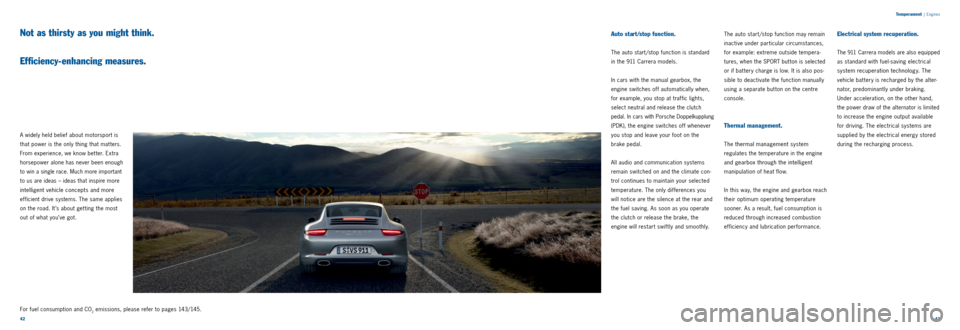
4243
A widely held belief about motorsport is
that power is the only thing that mat ters.
From experience, we know bet ter. Extra
horsepower alone has never been enough
to win a single race. Much more important
to us are ideas – ideas that inspire more
intelligent vehicle concepts and more
ef ficient drive systems. The same applies
on the road. It ’s about get ting the most
out of what you’ve got.
Auto start/stop function.
The auto start/stop function is standard
in the 911 Carrera models.
In cars with the manual gearbox, the
engine switches off automatically when,
for example, you stop at traffic lights,
select neutral and release the clutch
pedal. In cars with Porsche Doppelkupplung
(PDK), the engine switches off whenever
you stop and leave your foot on the
brake pedal.
All audio and communication systems
remain switched on and the climate con
trol continues to maintain your selected
temperature. The only differences you
will notice are the silence at the rear and
the fuel saving. As soon as you operate
the clutch or release the brake, the
engine will restart swiftly and smoothly. The auto start/stop function may remain
inactive under particular circumstances,
for example: extreme outside tempera
tures, when the SPORT but ton is selected
or if bat tery charge is low. It is also pos
sible to deactivate the function manually
using a separate but ton on the centre
console.
Thermal management.
The thermal management system
regulates the temperature in the engine
and gearbox through the intelligent
manipulation of heat flow.
In this way, the engine and gearbox reach
their optimum operating temperature
sooner. As a result, fuel consumption is
reduced through increased combustion
efficiency and lubrication performance.
Electrical system recuperation.
The 911 Carrera models are also equipped
as standard with fuel saving electrical
system recuperation technology. The
vehicle bat tery is recharged by the alter
nator, predominantly under braking.
Under acceleration, on the other hand,
the power draw of the alternator is limited
to increase the engine output available
for driving. The electrical systems are
supplied by the electrical energy stored
during the recharging process.
Temperament | Engines
Not as thirsty as you might think.
Efficiency- enhancing measures.
For fuel consumption and CO2 emissions, please refer to pages 143/145.
Page 23 of 76
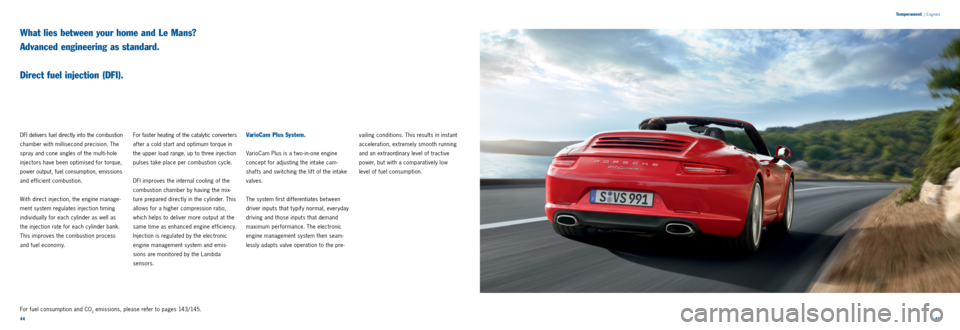
4445
DFI delivers fuel directly into the combustion
chamber with millisecond precision. The
spray and cone angles of the multihole
injectors have been optimised for torque,
power output, fuel consumption, emissions
and ef ficient combustion.
With direct injection, the engine manage
ment system regulates injection timing
individually for each cylinder as well as
the injection rate for each cylinder bank.
This improves the combustion process
and fuel economy. vailing conditions. This results in instant
acceleration, extremely smooth running
and an extraordinary level of tractive
power, but with a comparatively low
level of fuel consumption.
For faster heating of the catalytic converters
after a cold start and optimum torque in
the upper load range, up to three injection
pulses take place per combustion cycle.
DFI improves the internal cooling of the
combustion chamber by having the mix
ture prepared directly in the cylinder. This
allows for a higher compression ratio,
which helps to deliver more output at the
same time as enhanced engine efficiency.
Injection is regulated by the electronic
engine management system and emis
sions are monitored by the Lambda
sensors.
Temperament | Engines
VarioCam Plus System.
VarioCam Plus is a two in one engine
concept for adjusting the intake cam
shafts and switching the lift of the intake
valves.
The system first dif ferentiates bet ween
driver inputs that typify normal, everyday
driving and those inputs that demand
maximum performance. The electronic
engine management system then seam
lessly adapts valve operation to the pre
What lies between your home and Le Mans?
Advanced engineering as standard.
Direct fuel injection (DFI).
For fuel consumption and CO2 emissions, please refer to pages 143/145.
Page 24 of 76
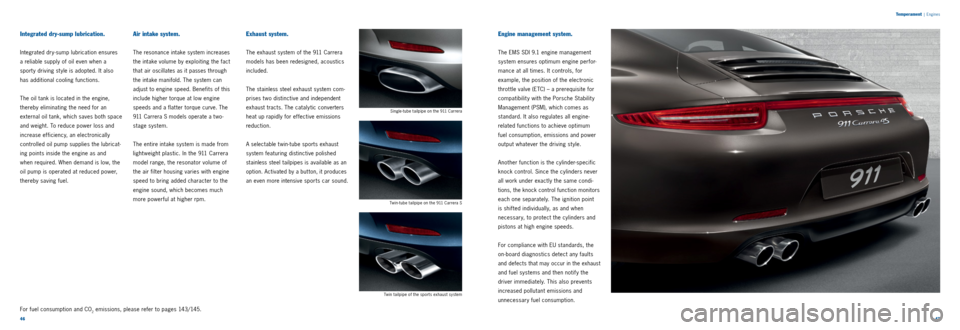
4647
Temperament
|
Engines
Integrated dry-sump lubrication.
Integrated dr y sump lubrication ensures
a reliable supply of oil even when a
sport y driving st yle is adopted. It also
has additional cooling functions.
The oil tank is located in the engine,
thereby eliminating the need for an
external oil tank, which saves both space
and weight. To reduce power loss and
increase efficiency, an electronically
controlled oil pump supplies the lubricat
ing points inside the engine as and
when required. When demand is low, the
oil pump is operated at reduced power,
thereby saving fuel.
Air intake system.
The resonance intake system increases
the intake volume by exploiting the fact
that air oscillates as it passes through
the intake manifold. The system can
adjust to engine speed. Benefits of this
include higher torque at low engine
speeds and a flat ter torque curve.
The
9 11 Carrera S models operate a t wo
stage
system.
The entire intake system is made from
light weight plastic. In the 9 11 Carrera
model range, the resonator volume of
the air filter housing varies with engine
speed to bring added character to the
engine sound, which becomes much
more powerful at higher rpm.
Exhaust system.
The exhaust system of the 911 Carrera
models has been redesigned, acoustics
included.
The stainless steel exhaust system com
prises t wo distinctive and independent
exhaust tracts. The cataly tic converters
heat up rapidly for effective emissions
reduction.
A selectable t win tube sports exhaust
system featuring distinctive polished
stainless steel tailpipes is available as an
option. Activated by a but ton, it produces
an even more intensive sports car sound.
Engine management system.
The EMS SDI 9.1 engine management
system ensures optimum engine perfor
mance at all times. It controls, for
example, the position of the electronic
throt tle valve (ETC) – a prerequisite for
compati bility with the Porsche Stability
Management (PSM), which comes as
standard. It also regulates all engine
related functions to achieve optimum
fuel consumption, emissions and power
output whatever the driving st yle.
Another function is the cylinder specific
knock control. Since the cylinders never
all work under exactly the same condi
tions, the knock control function monitors
each one separately. The ignition point
is shifted individually, as and when
necessary, to protect the cylinders and
pistons at high engine speeds.
For compliance with EU standards, the
on board diagnostics detect any faults
and defects that may occur in the exhaust
and fuel systems and then notify the
driver immediately. This also prevents
increased pollutant emissions and
unnecessary fuel consumption.
Twin tailpipe of the sports exhaust system Single
tube tailpipe on the 911 Carrera
Twin tube tailpipe on the 911 Carrera S
For fuel consumption and CO2 emissions, please refer to pages 143/145.
Page 25 of 76
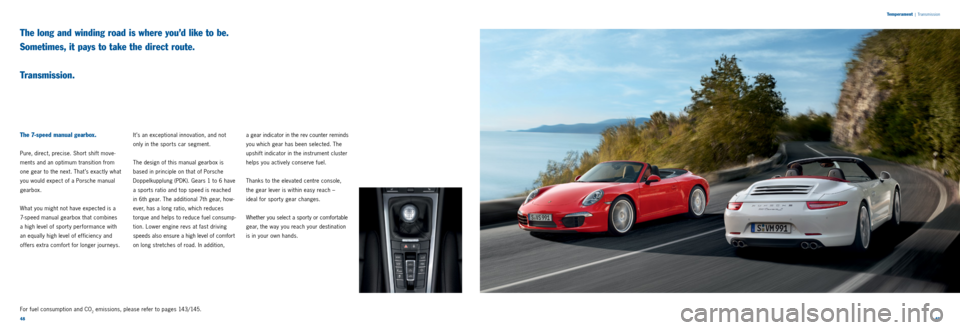
4849
Temperament
|
Transmission
The long and winding road is where you’d like to be.
Sometimes, it pays to take the direct route.
Transmission.
The 7-speed manual gearbox.
Pure, direct, precise. Short shif t move
ments and an optimum transition from
one gear to the next. That ’s exactly what
you would expect of a Porsche manual
gearbox.
What you might not have expected is a
7 speed manual gearbox that combines
a high level of sport y performance with
an equally high level of efficiency and
offers extra comfort for longer journeys. It’s an exceptional innovation, and not
only in the sports car segment.
The design of this manual gearbox is
based in principle on that of Porsche
Doppelkupplung (PDK). Gears 1 to 6 have
a sports ratio and top speed is reached
in 6th gear. The additional 7th gear, how
ever, has a long ratio, which reduces
torque and helps to reduce fuel consump
tion. Lower engine revs at fast driving
speeds also ensure a high level of com
fort
on long stretches of road. In addition
, a gear indicator in the rev counter reminds
you which gear has been selected. The
upshift indicator in the instrument cluster
helps you actively conserve fuel.
Thanks to the elevated centre console,
the gear lever is within easy reach –
ideal for sport y gear changes.
Whether you select a sporty or comfortable
gear, the way you reach your destination
is in your own hands.
For fuel consumption and CO
2 emissions, please refer to pages 143/145.
Page 26 of 76
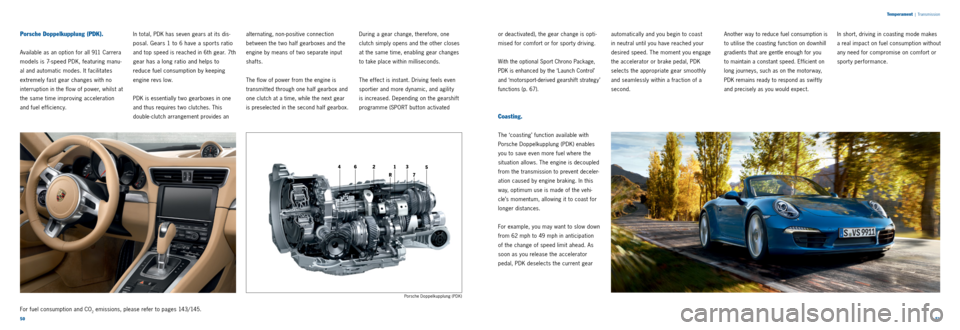
462135
7R
5051
Porsche Doppelkupplung (PDK).
Available as an option for all 911 Carrera
models is 7speed PDK, featuring manu
al and automatic modes. It facili
tates
extremely fast gear changes
with no
interruption in the flow of power, whilst at
the same time improving acceleration
and fuel efficiency. In total, PDK has seven gears at its dis
posal. Gears 1 to 6 have a sports ratio
and top speed is reached in 6th gear.
7th
gear has a long ratio and helps to
reduce fuel consumption by keeping
engine revs low.
PDK is essentially t wo gearboxes in one
and thus requires t wo clutches. This
double clutch arrangement provides an
Porsche Doppelkupplung (PDK)
alternating, non positive connection
bet ween the t wo half gearboxes and the
engine by means of t wo separate input
shafts.
The flow of power from the engine is
transmit ted through one half gearbox and
one clutch at a time, while the next gear
is preselected in the second half gearbox. During a gear change, therefore, one
clutch simply opens and the other closes
at the same time, enabling gear changes
to take place within milliseconds.The effect is instant. Driving feels even
sportier and more dynamic, and agility
is increased. Depending on the gearshift
programme (SPORT button activated
Temperament | Transmission
or deactivated), the gear change is opti
mised for comfort or for sport y driving.
With the optional Sport Chrono Package,
PDK is enhanced by the ‘Launch Control’
and ‘motorsport derived gearshif t strategy’
functions (p. 67).
Coasting.
The ‘coasting’ function available with
Porsche Doppelkupplung (PDK) enables
you to save even more fuel where the
situation allows. The engine is decoupled
from the transmission to prevent deceler
ation caused by engine braking. In this
way, optimum use is made of the vehi
cle’s momentum, allowing it to coast for
longer distances.
For example, you may want to slow down
from 62 mph to 49 mph in anticipation
of the change of speed limit ahead. As
soon as you release the accelerator
pedal, PDK deselects the current gear auto
matically and you begin to coast
in neutral until you have reached your
desired speed. The moment you engage
the accelerator or brake pedal, PDK
selects the appropriate gear smoothly
and seamlessly within a fraction of a
second. In short, driving in coasting mode makes
a real impact on fuel consumption without
any need for compromise on comfort or
sporty performance.
Another way to reduce fuel consumption is
to utilise the coasting function on downhill
gradients that are gentle enough for you
to maintain a constant speed. Efficient on
long journeys, such as on the motorway,
PDK remains ready to respond as swiftly
and precisely as you would expect.
For fuel consumption and CO2 emissions, please refer to pages 143/145.
Page 27 of 76
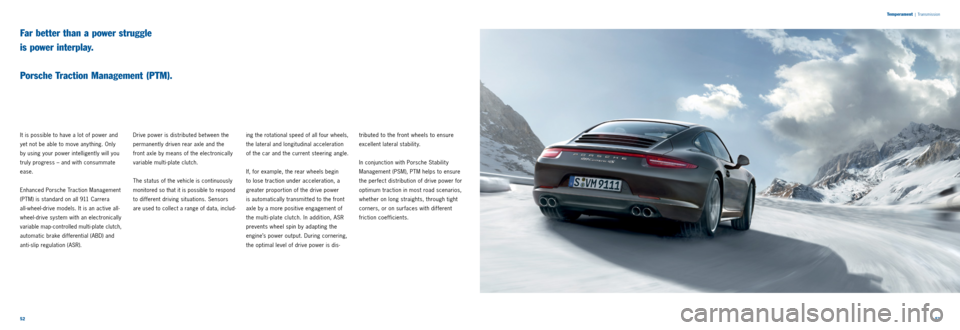
5253
T
emperament
| Transmission
It is possible to have a lot of power and
yet not be able to move any thing. Only
by using your power intelligently will you
truly progress – and with consummate
ease.
Enhanced Porsche Traction Management
(PTM) is standard on all 911 Carrera
all wheel drive models. It is an active all
wheel drive system with an electronically
variable map controlled multi plate clutch,
automatic brake differential (ABD) and
anti slip regulation (ASR). Drive power is distributed bet ween the
permanently driven rear axle and the
front axle by means of the electronically
variable multi
plate clutch.
The status of the vehicle is continuously
monitored so that it is possible to respond
to different driving situations. Sensors
are used to collect a range of data, includ
ing the rotational speed of all four wheels,
the lateral and longitudinal acceleration
of the car and the current steering angle.
If, for example, the rear wheels begin
to lose traction under acceleration, a
greater proportion of the drive power
is automatically transmit ted to the front
axle by a more positive engagement of
the multi plate clutch. In addition, ASR
prevents wheel spin by adapting the
engine’s power output. During cornering,
the optimal level of drive power is dis
tributed to the front wheels to ensure
excellent lateral stability.
In conjunction with Porsche Stability
Management (PSM), PTM helps to ensure
the perfect distribution of drive power for
optimum traction in most road scenarios,
whether on long straights, through tight
corners, or on surfaces with different
friction coefficients.
Far better than a power struggle
is power interplay.
Porsche Traction Management (PTM).
Page 28 of 76

5455
Temperament
| Chassis and body
“That can’t be done.”
If ever a sentence gave motivation to sports car designers, this is it.
Chassis and body.
A solid identit y tends to be described
with words like stability, directness or
substance. This might sound a lit tle
serious but, when it comes to the chassis
and body, we think that this is entirely
the right approach.
The best example is the engineered
design. Indeed, dynamic per formance
and ride comfort fundamentally depend
on factors such as vehicle weight, body
rigidity, wheelbase, axle construction
and steering. With the 911, we challenged
our engineers to push the boundaries
of what is possible. Chassis control systems make a key
contribution to the 911 driving experience
and thus to the 9 11 i d e n t i t y. T h e s e
include Porsche Stability Management
(PSM), Porsche Active Suspension
Management (PASM), which comes as
standard in the 911 Carrera S models,
Porsche Torque Vectoring Plus (PTV Plus).
Porsche Dynamic Chassis Control (PDCC)
is additionally available as an option for
the
9 11 Carrera S models.
Yet, there is still scope for improvement
as far as sport y performance is
concerned. The optional Sport Chrono Package triggers an adrenaline rush
at the push of a but ton. Dynamic engine
mounts, until now exclusively reserved
for 911 GT and Turbo models, may not be
capable of breaking the laws of physics
but they do succeed in exploiting them
to their own advantage – and yours.
Page 29 of 76
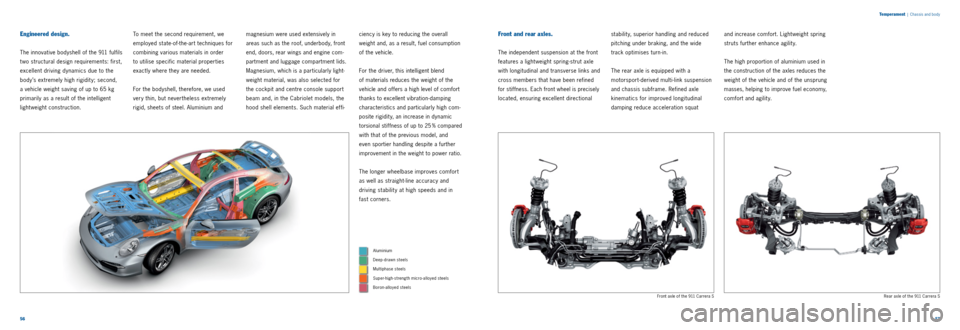
5657
Temperament
| Chassis and body
Engineered design.
The innovative bodyshell of the 911 fulfils
t wo structural design requirements: first,
excellent driving dynamics due to the
body’s extremely high rigidit y; second,
a vehicle weight saving of up to 65 kg
primarily as a result of the intelligent
lightweight construction. To meet the second requirement, we
employed state
of the art techniques for
combining various materials in order
to utilise specific material properties
exactly where they are needed.
For the bodyshell, therefore, we used
very thin, but nevertheless extremely
rigid, sheets of steel. Aluminium and magnesium were used extensively in
areas such as the roof, underbody, front
end, doors, rear wings and engine com
partment and luggage compartment lids.
Magnesium, which is a particularly light
weight material, was also selected for
the cockpit and centre console support
beam and, in the Cabriolet models, the
hood shell elements. Such material effi ciency is key to reducing the overall
weight and, as a result, fuel consumption
of the vehicle.
For the driver, this intelligent blend
of materials reduces the weight of the
vehicle and offers a high level of comfort
thanks to excellent vibration damping
characteristics and particularly high com
posite rigidit y, an increase in dynamic
torsional stiffness of up to 25 % compared
with that of the previous model, and
even
sportier handling despite a further
improvement in the weight to power ratio.
The longer wheelbase improves comfort
as well as straight line accuracy and
driving stabilit y at high speeds and in
fast corners.
Front and rear axles.
The independent suspension at the front
features a light weight spring strut axle
with longitudinal and transverse links and
cross members that have been refined
for stiffness. Each front wheel is precisely
located, ensuring excellent directional stability, superior handling and reduced
pitching under braking, and the wide
track optimises turn
in.
The rear axle is equipped with a
motorsport derived multi link suspension
and chassis subframe. Refined axle
kinematics for improved longitudinal
damping reduce acceleration squat and increase comfort. Light weight spring
struts further enhance agilit y.
The high proportion of aluminium used in
the construction of the axles reduces the
weight of the vehicle and of the unsprung masses, helping to improve fuel economy,
comfort and agility.
Rear axle of the 911 Carrera S
Front axle of the 911 Carrera S
Aluminium
Deep
drawn steels
Multiphase steels
Super high strength micro alloyed steels
Boron alloyed steels
Page 30 of 76
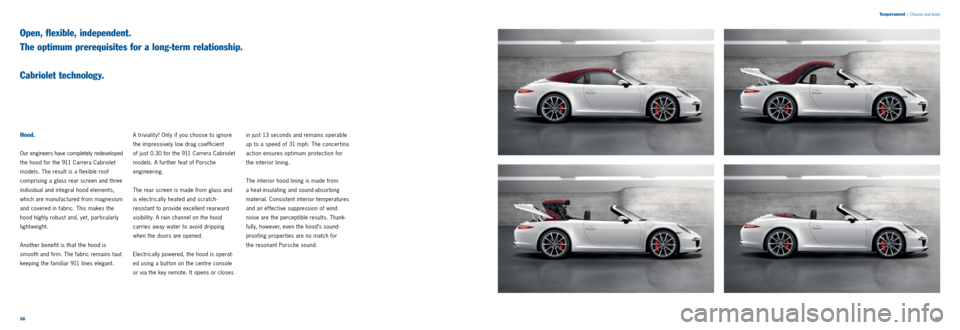
5859
T
emperament
| Chassis and body
Hood.
Our engineers have completely redeveloped
the hood for the 911 Carrera Cabriolet
models. The result is a flexible roof
comprising a glass rear screen and three
individual and integral hood elements,
which are manufactured from magnesium
and covered in fabric. This makes the
hood highly robust and, yet, particularly
lightweight.
Another benefit is that the hood is
smooth and firm. The fabric remains taut
keeping the familiar 911 lines elegant. A trivialit y? Only if you choose to ignore
the impressively low drag coefficient
of just 0.30 for the 911 Carrera Cabriolet
models. A further feat of Porsche
engineering.
The rear screen is made from glass and
is electrically heated and scratch
resistant to provide excellent rearward
visibilit y. A rain channel on the hood
carries away water to avoid dripping
when the doors are opened.
Electrically powered, the hood is operat
ed using a but ton on the centre console
or via the key remote. It opens or closes in just 13 seconds and remains operable
up to a speed of 31 mph. The concertina
action ensures optimum protection for
the interior lining.
The interior hood lining is made from
a heat insulating and sound absorbing
material. Consistent interior temperatures
and an effective suppression of wind
noise are the perceptible results. Thank
fully, however, even the hood’s sound
proofing properties are no match for
the resonant Porsche sound.
Open, flexible, independent.
The optimum prerequisites for a long-term relationship.
Cabriolet technology.